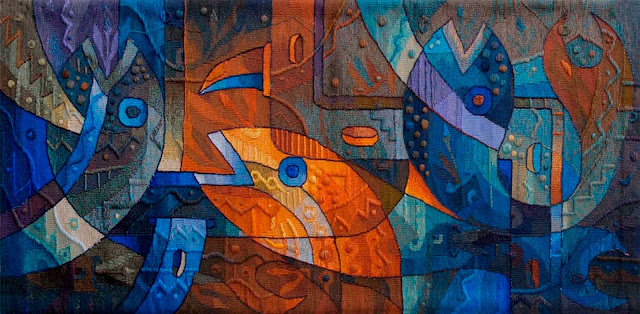Maximo Laura
“My work is nourished by symbols, stories, traditions, rituals, experiences, and by permanently returning to admire the iconography of ancestral world cultures, especially Peruvian culture – which are extraordinary and fascinating.”
Maximo Laura
Maximo Laura is a Peruvian weaver whose work is timeless. He uses modern weaving techniques to recall the Andean rituals that were expressed by his Pre-Columbian ancestors hundreds of years ago. He is a tapestry weaver, internationally recognized as one of South America’s pre-eminent textile artists and the pride of Peru - his country of birth. Maximo is a scholar of textile art and has travelled the world exploring and teaching in his field. Consultant, designer and lecturer in Art and Contemporary Andean textile design. His work is in collections worldwide and has been exhibited 71 solo and numerous group shows. In fact, in the national museum in Lima, there is a whole room devoted to his work. He has won awards in both national and international competitions including a UNESCO Prize for Latin America and the Caribbean (Spain, 1992), among others. He is co-founder of Iberoamerican Textile Network, member of ATA and ETN.
Laura is a fifth-generation master weaver who inherited from his parents and grandparents – all master weavers from Ayacucho, Peru – the traditional style of ancient weaving called Cumbimayocs. He combines also Aubusson, Kilim, Soumak, and Anillado techniques; his thread is from Andean alpaca. But while he is ultimately respectful of the iconography and colours of the ancient Huari culture (which predates the Inca culture), it is his juxtaposition of those traditions with his own design elements and narrative that have earned him many international awards, distinctions and exhibits.
Maximo has taken the tapestry weave to a different level. He is constantly enhancing his unique technique of raising the weft to create incredible depth to his tapestries. His work is the rich, singular development of the fascinating and millenarian textile historical source of the Andes in symbiosis with the innovations of the tapestry in the international field, defending its own space in the plastic arts. The historical sources contribute inexhaustible material that must be assimilated, the search of language own and present is the ample challenge to be surpassed. Of this collision between traditional and the contemporary, study of the tools, the application and the innovation of textile techniques he tries to multiply the resources of chromatic expression maintaining the iconographic language authentically Peruvian....
Maximo Laura is what we could call "the weaver of rupture," seeing beyond the selfsame conception of textiles. His tapestries become pieces of art the same as paintings. His codes will not repeat themselves; nor will they have geometric order. Instead, they will appeal to the dynamics of their own subjects. Just like a painting. Finally, his own fingers become his brushes, threads and cords his palette of colours and his loom his comfortable easel. Colour undoubtedly prevails in his finished pieces. Each fibre will have a rigorous chromatic value. The dyes, their gamut of colours, have a special history, a scientific work reevaluating thousands of years.
Weaver-painter through his creative style, he designs with innate skill both forms and colours, dominating codes that blend into a composition of fibres magically entwined by the incantation of his forms. The conjunction of pre-Columbian cultures becomes entwined, finally turning into a sort of opera omnia.
Maximo Laura’s respectful research of his ancestor's genuine colours, has found and revealed some of the secrets in their colours and fibres. But where he really stands out is in the use of design. Maximo has not stopped at the weaver's direct and personal action at the loom. For him, weaving is not the unfolding of direct action but breaking point in its conceptual order. His work is a fusion of traditional weaving technique of tapestry alongside a progressive woven sculpture technique; traditional tapestry and contemporary style with three-dimensional representations of Andean mythological themes drawn from Peru's rich history of pre-Columbian cultures such as the Incas and their modern day descendants. They are full of vision, ritual, and ancient myths. These pieces are an experience, a collision between the traditional and the contemporary. The iconographic language is authentically Peruvian.
Laura has his own gods, his own ghosts and an unruly mob of ineffable warriors. Clarion calls, voices in the wind, fiery sunsets and horizons made of a thousand coloured fibres; shapes and colours in the warp that seem to obey their creator's strength; a true brushstroke on tapestry, breaking the crossbar's rule and discovering a magical conjunction. He has many stories to reveal. War cries, brave felines and birds and mountain songs live in his mind, in history books and in the myths and tales he inherited from his grandparents.
He combines geometric shapes with animals, people, musical instruments, and many other themes. You can stand in front of his work and get lost in the layers. Each piece seems to be a narrative of an ancient story, a landscape of imagery and dreams. You can never quite tell where one picture, scene, character or subject begins and another finishes; there are overlaps and conversations amongst all of the images in his tapestries.
Although tapestry weaving is an ancient technique, Máximo Laura has brought it into the 21st Century with his modern design ideas and use of colours. Laura fibre art designs may be contemporary or cultural or a combination of both. Today, Maximo Laura represents, in the eye of the specialist and the layman, the artist who has been able to entwine past and present. The social inheritance of many generations of Peruvians who, like him, did not stop at the penetration of other cultures; but, through their creativity, were instead able to enhance and deepen that inheritance whose telluric force will never be refrained.

















2 comments:
Absolutely breathtaking!
Very inspiring. Oxford, England.
Post a Comment